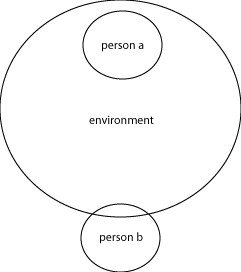Following on from this post, Stephen submits that the system we need to create is:
“a complex construction that enables, first, a wide variety of experiences akin to (and possibly extending upon) our experiences of the natural world: things to see, touch, do, and otherwise sense; and second, a mechanism for interpreting and comprehending this experience, a syntax, putting it into a structure, a semantics, which assigns it meaning, and a pragmatics, that gives it a context and use”
Which makes my head hurt a little but which resonates well with Ulises’s comments in OSN05 (hence you have to login) that the wise thing to do is to steer away from social or technological deterministic ways and think instead of ‘affordances’:
“which Paul Dourish (based on Norman’s work) defines as a 3-way relationship between the environment, the actor, and the activity.” [he also points to this transcribed(!) discussion on the subject]
So, trying to conceptualise this myself I guess I’d contend that every ‘constructed’ online environment (in the sense of specific rather than generalised principles of design) I have participated in has been established with the following principles in mind:
-The ‘natural world’ Stephen refers to is able to be constructed within a bounded – in terms of space and ‘hackability’ – environment.

-The ‘mechanism’ he also brings up and which mediates the 3-way relationship described by Ulises is something that exists away from the individual, requiring remote / projected participation (as it is with person a, person b existing in quite a different, latticed relationship).

Again, I feel like blogs and RSS, or most certainly elements of these two practices and technologies in am enabled context, have a large role to play in approaching these environments and relationships anew (person b-esquely) but I want to read some more (especially Ulises Online Discourse and Distributed Textual Discourse and besides I’ve gotta get a podcasting blog up and running for tomorrow morning… eek.
I really wish I had more time to spend at OSN2005. I registered and attended but the time slipped away from me with work, etc…
With regards the concepts, I wonder where we are going with this. In my world of scanning madly the mediasphere and the blogosphere, I find my experiences less and less contextual and merely self-referencial. Mind you, there are always links away, but the nature of the Opinion Leader, when aggregated into a RSS client or something similar, can result in everything out of context. And the synthesis can be pretty amazing, and more often then not surprising. Where the patterns are not based on subject or topic but rather on time (when it was posted and what was going on in the world) or some other less obvious influencer. In my work, I need to at least keep track of blogs from the left, right, from the up and down, from the legal profession and into IP law, from hither to thither, and the more I think these feeds are diverse and balkanized, the more I realize that they are mere different wavelengths of the same energy. IR and UV and the visible spectrum are, out of context of the medium unless you know that they are all light. In this case, I believe sound waves would be more apropos, because in this case, the blogosphere and in many way, social networks (both online and off) are echochambers. Cascading, realtional, asynchronous call-call-response ripples. And although those diagrams above make a lot of sense, I do believe that the true diagram would look more like raindrops rippling in concentric circles, interfering, intermingling, comingling, and then becoming still (or at least invisible to the naked eye) until reanimated (or ampliphied) by new rain drops. Without the energy of the rain, the water returns to balance. The Internet, like the pond, is merely a neutral solution in which things (sound, light, color, dye, etc) can be suspended or introduced. Without external energy, entropy takes over and then, to return to my analogy, the pond is again a placid mirror, glassy and neutral.
” Cascading, realtional, asynchronous call-call-response ripples… true diagram would look more like raindrops rippling in concentric circles, interfering, intermingling, comingling, and then becoming still (or at least invisible to the naked eye) until reanimated (or ampliphied) by new rain drops.”
Chris, that’s beautiful, wow! I think we’re heading along the same lines here, pools and raindrops… v. cool.
Thanks for the comment, I’m having quite a cognitive splash!
Am going to repost this!
Cheers, James